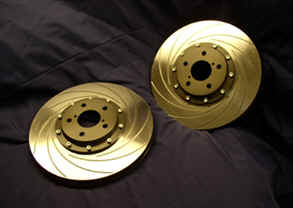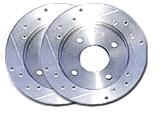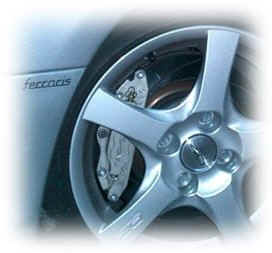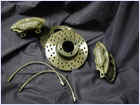The TAR-OX
4-Pot caliper brake system is recommended for light cars under 700kg with wheels
smaller than 14”. Particularly suitable for cars like the 'old' Mini Cooper.
6-Pot Brake Caliper Kit

Fitting a TAR-OX upgrade kit will give you
amazing braking performance and total confidence. By matching six piston
calipers to the discs, problems such as disc failure, deformation and
vibration are eliminated . TAR-OX offer a variety of calipers to suit
various applications and customer requirements. The diameter of the
pistons in the calipers are specific to each application to take into
account the car's master cylinder.
Each kit contains 2 six pistons brake calipers, 2 brake discs including
alloy bells, 2 adaptor clamps, 1 set of brake pads and 1 set of brake
lines
The conversion kits are available with the spiral grooved F2000
discs as standard or with Sport
Japan Plus or D95
discs as an option.
10-Pot Brake Caliper Kit
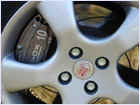
TAR-OX is the only manufacturer in the world
to offer a TEN pot caliper for road and track day use.
By matching 10 piston calipers to the discs, you achieve:
1. More evenly distributed pressure on the pads,
2. Better cooling action of the pads, because of more airflow behind the
pad's metal support
3. Less stress factor on the caliper itself
4. More clamping action resulting in more braking power due to the
presence of more pistons
5. Firmer pedal Strongly recommended for cars that suffer from a spongy
pedal,
TAR-OX offer a variety of calipers to suit various applications and
customer requirement. The diameter of the pistons in the calipers are
specific to each application to take into account the car's master
cylinder.
Each kit contains 2 ten pistons brake calipers, 2 brake discs including
alloy bells, 2 adaptor clamps, 1 set of brake pads and 1 set of brake
lines
The conversion kits are available with the spiral grooved F2000
discs as standard or with Sport
Japan Plus or D95
discs as an option. For top end performance, ten pot brake conversion kits
are also available with Metal/Ceramic discs.
12-Pot B350 Brake Caliper Kit
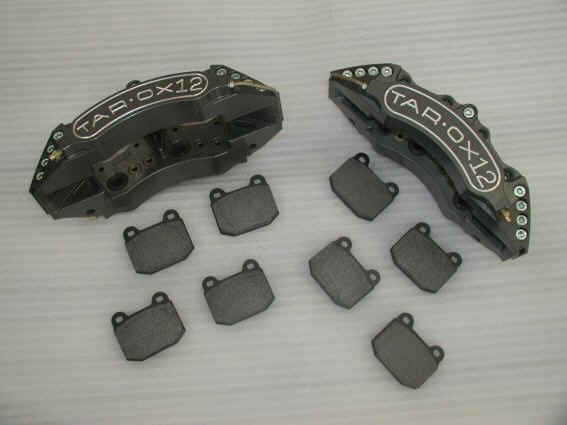
TAR-OX
BRAKE PADS
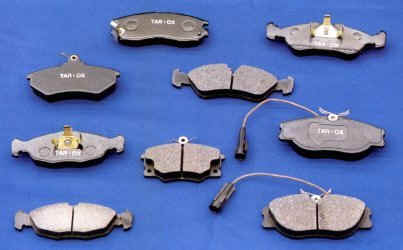
 Strada
(.112)
Strada
(.112)
These
pads are ideal for fast road use and every day driving. They work from cold and
provide immediate response without
pre-heating like an O.E pad but at the same time offer a higher coefficient of
friction for improved braking power, improved resistance to high temperatures
and a longer service life than O.E materials. Provides excellent pedal feel and
allows full control over braking for the driver.
Able
to withstand temperatures of up to 600°C this
pad has an optimum temperature range of 150°C to 200°C, for best results do
not exceed disc temperature of app. 400°C.
mHot
= 0,38
mTypical
= 0,35
- Low
noise in most driving conditions
- Low
disc wear
- Available
for most applications
- Gives
a good pedal feel
 Rallye
(.113)
Rallye
(.113)
These
pads are designed specifically for fast road use. They are perfectly suited to
spirited driving on B-roads and country lanes. As with the Strada pad, they work
virtually from cold but at the same
time they offer a higher coefficient of friction for superior braking power.
Unlike many uprated pads which are either on or off, these pads offer a more
progressive feel which allows the driver to have constant control over the
braking effort of the vehicle.
Able
to withstand temperatures of up to 700°C this
pad has an optimum temperature range of 200°C to 300°C, for best results do
not exceed disc temperature of app. 500°C.
mHot
= 0,40
mTypical
= 0,35
- Low
noise in most driving conditions although can be slightly noisy at low
speeds
- Low
disc wear
- Available
for most performance car applications
- Gives
a good, progressive pedal feel
 Rallye
+ (.401)
Rallye
+ (.401)
Like
the Rallye pad these pads are ideal for fast road use, but also offer excellent
performance for light track day use. As with the Rallye compound, the Rallye+
works virtually from cold but has a slightly higher coefficient of friction and
wider optimum operating temperature which makes it ideal for light track use in
most small performance cars and hot hatches. Gives a very responsive pedal feel
due to the low compressibility level. Will withstand high brake disc
temperatures due to heat treating of the pad surface. The Rallye+ pad also
features film transfer technology which prolongs disc and pad life.
Able
to withstand temperatures of up to 750°C this
pad has an optimum temperature range of 200°C to 350°C, for best results do
not exceed disc temperature of app. 550°C.
mHot
= 0,41
mTypical
= 0,35
- Pad
surface is heat treated, which helps reduce brake fade
- Low
disc wear
- Will
generate a Transfer Film on the disc surface when running hot
- Available
for selected applications
- Low
noise in most driving conditions although can be slightly noisy at low
speeds
- Gives
a good pedal feel
 Corsa
(.114)
Corsa
(.114)
The
Corsa pad is a great all – round pad, although primarily intended for race and
track day use the pads can also be used to great effect for fast road use .
Corsa pads are effective from cold and therefore give maximum performance at all
temperatures. The high coefficient of friction gives plenty of pedal feel and
massive amounts of bite, yet they are not hard on discs like some track type
pads.
Able
to withstand temperatures of up to 800°C this
pad has an optimum temperature range of 200°C to 400°C, for best results do
not exceed disc temperature of app. 600°C.
mHot
= 0,47
mTypical
= 0,43
- Low
disc wear
- Available
for selected performance applications
- Low
noise in most driving conditions although can be slightly noisy at low
speeds
- Gives
a good pedal feel
 Corsa
+ (.501)
Corsa
+ (.501)
The
ultimate street usable pad in the Tarox range, designed with very fast road and
hard track use in mind. These pads perform best when warmed up, but still offer
braking power when cold. Can be slightly noisy in certain applications if used
on the street at low speed. This compound can withstand near race conditions in
terms of brake disc temperature. Has a very responsive pedal feel due to even
lower compressibility but it still gives plenty of control to the driver.
Able
to withstand temperatures of up to 900°C this
pad has an optimum temperature range of 250°C to 550°C, for best results do
not exceed disc temperature of app. 700°C
mHot
= 0,48
mTypical
= 0,36
- Pad
surface is heat treated, which helps reduce brake fade
- Low
disc wear
- Will
generate a Transfer Film on the disc surface when running hot
- If
used for street use, the pads are equipped with anti noise shims in line to
OE, where applicable
- Available
for certain specially selected applications
 Sintered (.115)
Sintered (.115)
Formulated
for fast road use with the Tarox Metal-Ceramic discs, but also a very effective
race compound for use on regular
cast discs. They give a very hard, racecar style pedal feel due to the very
lowest compressibility level and although these pads are race orientated they
still give the driver full control over braking effort.
Able
to withstand temperatures of over 900°C this
pad has an optimum temperature range of 350°C to 650°C, for best results do
not exceed disc temperature of app. 800°C.
mHot
= 0,53
mTypical
= 0,46
- Long
pad and disc lifetime, even under racing conditions.
- Good
initial bite and very consistent performance when heated
- Firm
pedal feel due to very low compressibility level.
- Recommended
for track use on cars equipped with Tarox 6/10 pot calipers
- Available
for certain specially selected applications
 Racing (.601)
Racing (.601)
Suitable
for race use. This is the material to use for pure racing. It will however give
superior performance for road use when combined with Tarox Metal-Ceramic discs.
Very hard pedal feel due to a low compressibility level. Has a superior release
characteristic compared to other race materials making it easier to modulate.
Will generate a transfer film when used hard on track.
Able
to withstand temperatures of over 900°C this
pad has an optimum temperature range of 300°C to 700°C, for best results do
not exceed disc temperature of app. 800°C.
mHot
= 0,53
mTypical
= 0,47
- Pad
surface is heat treated, which helps reduce brake fade
- Long
pad and disc lifetime, even under racing conditions, due to Transfer Film
Technology.
- High
initial bite and very consistent performance lap after lap.
- Firm
pedal feel due to very low compressibility level.
